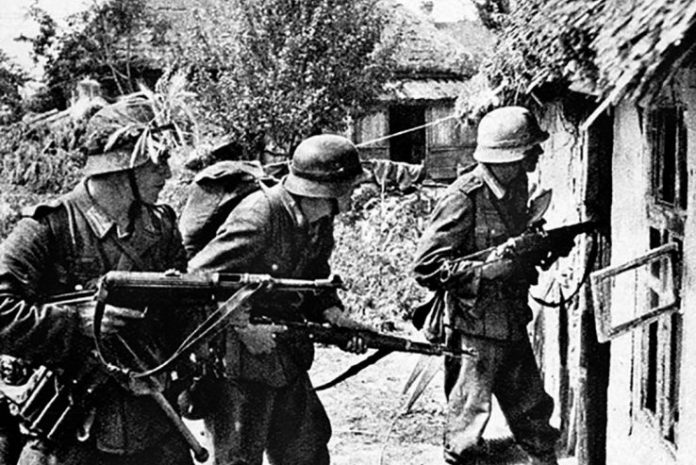
History of hulhuta 05/03/20: what frightened the Germans occupied the easternmost locality of the USSR
Today hulhuta — insignificant urban-type settlement in Kalmykia. Despite the fact that hulhuta via the Federal highway, the village, like most such settlements, slowly losing population. But in 1942 between the red Army and the Wehrmacht for this village turned violent fights, which was very important for the further progress of the war. Nevertheless, the war in the Kalmyk steppe is still an obscure topic for the domestic reader. In 2014, Kalmyk Institute of Humanities research, has published a collection of articles that shed light on many episodes of battles on the Astrakhan direction. Of particular interest is, so to speak, a look from the other side: the German occupation of the Kalmyk ASSR was reflected in photographs and diary entries made by soldiers and officers of the Wehrmacht.
the Germans in Kalmykia
the 16th motorized division was formed in münster (North Rhine-Westphalia). During the offensive in the summer of 1942 at Astrakhan the direction of the division, being a member of the army group “A” were able to take Hulhulo, a small settlement on the territory of the Kalmyk ASSR, which became the easternmost point of the Soviet Union captured by the Germans. At that time, Kalmykia was a national outskirts, the inhabitants of which, in spite of the actions of the Soviet regime, continued to lead a largely traditional way of life. Exotic Kalmyks-Buddhists have caused the Germans a genuine interest. And since the soldiers of the Wehrmacht were allowed to not only keep personal diaries, but to have a camera, then during the period of occupation of Kalmykia has issued a large number of photos.
At first glance it may seem that the authors of all images were not invaders, but anthropologists or tourists. Their cameras carefully recorded of StAnya landscapes, exotic camels, dwellings and way of life of the local population, as well as Kalmyks themselves: remaining in the occupation of women, children and the elderly. Nazi propaganda worked, so to speak, on both sides. Not only local people but also the Germans themselves had to consider the military machine of the Wehrmacht as a means of liberation of the peoples from the yoke of Bolshevism. Played its role and created by writer Rudyard Kipling the colonial image of a civilized European vehicle “burden” whites. The photographs and video footage frame strongly emphasized the poverty and savagery of the locals who eat with their hands, sitting on the ground and live in huts. They contrasted the image of a German soldier, a warrior and a pioneer in one person, armed with a gun and a camera.
However, if you look closely to the photos becomes apparent one important detail. None of the photographs of the Kalmyks not smiling. Only a crooked grin Kalmyk women, Smoking a pipe, in one of the photos resembles a smile. Maybe it’s in the Eastern restraint and the habit to hide his emotions. But too clearly seen that these people are photographed with obvious reluctance, and certainly not perceive the newcomers as liberators. According to eyewitnesses, a significant portion of Germans do extremely contemptuous of the local population.
Fighting in the desert
Almost immediately the German high command launched a broad propaganda campaign among the Kalmyks and began to establish a civil administration. In Elista were published in the newspaper “Teegan heard” coming in the Kalmyk language. On the occupied territory arrived some leaders of the white emigration who have been working with the Kalmyks collected from armed groups. But at the same time, the region was growing guerrilla movement. According to estimates of V. I. Pyatnitsky, by the autumn of 1942 in the rear of the German army were about 300 guerrillas who operated mobile groups of 10-12 people.
the Guerrillas not just UDAplanned to disrupt the military and economic plans of the Germans. During the occupation, were liquidated more than 200 soldiers and officers of the Wehrmacht, blown up some weapons warehouses, and destroyed 6 aircraft and dozens vehicles and other equipment. Particularly sensitive was the guerrilla sabotage associated with the destruction of food stocks, which in the harsh conditions of deserts was worth its weight in gold.
Depressing have an effect on the Germans (and especially the Romanian units) and the harsh climate. In the summer the heat was unbearable, the sun was beating down mercilessly, and in the inhospitable steppes did not grow anything that could cast a saving shade. Early winter of 1942 worsened the situation. The heat was replaced by cold. From the steppe blew icy winds, meets on its way any obstacles. The ground was frozen with ice. But the most challenging was the lack of water. Its quality left much to be desired due to the large number of sulfur compounds. And in the area of Hulhule at that time there was only one well.
September 4, 1942, the 28th army of General Vasily Gerasimenko counterattacked. Began the bloody battle for Hohoto, which lasted until the end of November. The only well periodically passed from hand to hand, but sometimes becomes the object of a gentleman’s agreement by which the warring parties in turn were sent to him in jars, stopping the fire. However, as the veteran recalls fighting at Hulhulau Alexander Surov, this agreement is often violated. On 24 November, the German defense was broken, and the 28th the army moved to Elista, which was released on new year’s eve 31 Dec 1942. The following new year 28th army met, freeing Ukraine. But according to many soldiers, the battle of Hulhulau remained in their memory as the most difficult.
Igor konchakivs’ka
Source:
© Russian Seven
Recommended statesalaska… Share: Comments Comments on the article “Xolguta: what frightened the Germans occupied the easternmost locality of the USSR” Please log in to leave a comment! br>
Share on Tumblr
















